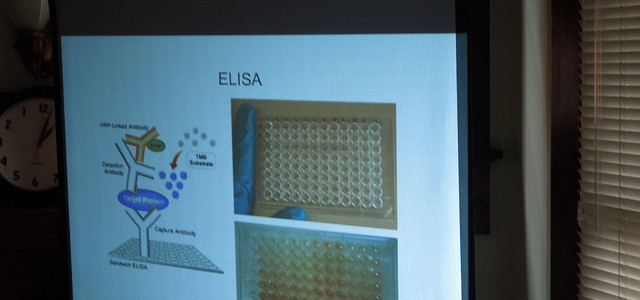
You can do ho-hum ELISAs or you can do Excellent ELISAs!
Here are some tips for moving from the every day to the extraordinary:
Increase your signal
If your signal is poor due to low antigen concentrations, there are a couple of tricks you can try:
- Use an indirect ELISA to amplify the signal
- Try a sandwich ELISA to pull your antigen away from other competing proteins
- Concentrate your samples prior to coating the plates
- If you think your antigen doesn’t absorb well to the plates or is oriented poorly, attach the antigen using a helper protein or biotinylation
- Use a different detection reagent to increase sensitivity – chemiluminescent and fluorescent assays are more sensitive then chromogenic assays
Do a stand-up standard curve
If you are using a standard curve, challenge yourself to make it the best curve you can. After all, the better your standard curve is, the more accurate your data will be.
- When reconstituting a standard, make sure you spin the contents to the bottom before opening the vial to recover all the powder
- Be careful when pipetting your dilutions and make sure your pipettes are accurate
- Use the same diluent for your standard curve and your samples
Be aware of your surroundings
ELISAs are sensitive to temperature. Colder temperatures can decrease your signal while elevated temperatures can lead to high background. Don’t perform your assays near air conditioners, heaters, cold windows, air vents or in bright sunlight.
Make sure your reagents and plates are at the proper temperature for the assay (most of the time room temperature).
Also remember that some substrates are sensitive to light and require incubation in the dark.
Optimize, optimize, optimize!
Ahh, the researcher’s lot in life is to perform multiple optimizing experiments before performing the actual experiment. ELISAs are no different. Just like Western blots, ELISAs can be optimized at multiple steps:
- Adsorption of antigen to plate
- Choice of blocking buffer
- Antibody titration
- Incubation times and temperature
- Wash buffer composition and time and length of washes
- Use positive and negative controls
Make sure you take the time to optimize your assay for the best results.
Use sealing tape
You know those thin pieces of plastic you can use to cover microtiter plates? Use them! Covering your wells during incubations will prevent particulates from falling into your wells. It will also prevent your wells from drying out during longer incubations. Also, in case you happen to be accident prone like me, covering the wells with film will prevent sloshing and contamination between wells in the event plates are accidentally bumped.
Don’t be ruined by robots
Automatic washers can save you time and decrease your chances of developing pipetting injuries in the future. But they can also ruin your ELISA when they are not maintained properly. Microbial contamination of tubing and lines can decrease your signal or cause high background. Make sure your instrument is cleaned on a regular basis.
Also be aware that a previous user may have used a wash buffer that is not compatible with your assay. Prime the system with your wash buffer.
Using the whole kit and kaboodle
Kits can simplify things and are especially useful for the novice ELISA researcher. Here are a couple of things to remember when using kits:
- Check the expiration date on the kit before use. Sometimes they can be used once the expiration date has passed, but you don’t want an old kit to be the reason why your assay isn’t working
- Components of kits can have different storage requirements – make sure you separate and store the components appropriately. But don’t lose them!
- Don’t mix kit components between different kits unless they have the same lot number
Layering it
If you are using an indirect sandwich ELISA, take extra care when choosing your antibodies. Make sure your detection antibody only recognizes the primary antibody and doesn’t recognize the capture antibody, or your entire assay could be ruined. A good “rule of thumb” is to use capture and primary antibodies that are made in different species as well as buying a highly cross-adsorbed secondary antibody, such as those sold by Advansta.
Use these tips to get the most out of your ELISAs. And if you have tips of your own, share them with us below.
Photo courtesy of thekirbster.

Leave a Reply